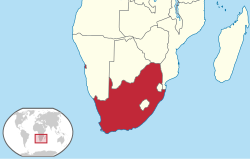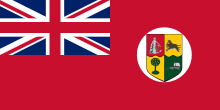South African Union
|
|||||
|
National motto : Ex Unitate Vires ( Latin : power through unity ) |
|||||
| navigation | |||||
|
|||||

|
|||||
| Official languages | Dutch ; Afrikaans subsumed under Dutch from 1925; English . | ||||
| Capital | Legislative: Cape Town Executive: Pretoria Judicial: Bloemfontein |
||||
| Form of government | Constitutional monarchy | ||||
| Government system | Parliamentary minority democracy | ||||
| Last monarch | Queen Elizabeth II. | ||||
| Last governor-general | Charles Robberts Swart | ||||
| Last Prime Minister | Hendrik Frensch Verwoerd | ||||
surface
|
2,045,320 km² incidental |
||||
population
|
18,216,000 8.91 / km² |
||||
Net domestic product
|
ZAR 266 million ZAR 5.036 billion |
||||
| independence | from the United Kingdom May 31, 1910 May 31, 1961 |
||||
| currency | South African pound | ||||
| Time zone | UTC +2 | ||||
| National anthem | The Stem van Suid-Afrika | ||||
The Union of South Africa ( Dutch Unie van Zuid-Afrika ) was established on 31 May 1910 by the union of four British colonies Cape Colony , Natal , the Orange River Colony and the Transvaal Colony , both of which last until the Second Boer War as the Orange Free State respectively . when the South African Republic ("Boer Republic") were independent.
The provinces of the Union were henceforth called Cape Province , Natal , Orange Free State and Transvaal . On May 31, 1961, the South African Union became the Republic of South Africa .
Domestic politics

Unlike Canada and Australia, the Union was not a federation . The parliaments of the colonies were abolished and replaced by provincial councils. The Union's legislature was a bicameral parliament , consisting of the National Assembly and the Senate , both of which were largely elected by the white minority population.
The right to vote in Cape Province and Natal was tied to land ownership, while in the Orange Free State and Transvaal, even after the Union was founded, blacks had no right to vote. As early as the first years of the Union, “racial” ways of thinking as the construction of a system of privileges gradually became the determining essence of domestic politics. In this regard, the Natives Land Act, which came into force in 1913, triggered the founding of the South African Native National Congress (SANNC), later the ANC, as a political organization of "civilized blacks". The following year, Barry Hertzog, dismissed from government for his pro-Boer stance, founded the National Party . The two parties were to decisively shape the history of South Africa in the 20th century.
There was rivalry between the provinces over the seat of the capital . The compromise solution was that Cape Town became the seat of Parliament, Pretoria the seat of government and Bloemfontein the seat of the Supreme Court. The capital of the Natal province, Pietermaritzburg, received financial compensation. This situation still persists today and results in ministers, officials and diplomats moving from Pretoria to Cape Town each year when there are parliamentary sessions and back to Pretoria when they are not.
Foreign policy
As a self-governed Dominion of the Empire and later the Commonwealth, the Union remained under the British Crown , which was represented in South Africa by a Governor General. A prime minister was at the head of the government. Louis Botha , a former Boer general, became the Union's first Prime Minister to head a coalition representing the Boers and English-speaking whites. In contrast to the other Dominions Canada , Australia , New Zealand , Irish Free State and Newfoundland , the whites in South Africa were in the minority and could only maintain political power by restricting the rights of the black majority. The Union obtained legislative independence from Great Britain with the Statute of Westminster on December 11, 1931, like the other Dominions .
Conflicts
In addition to the racially charged conflicts of interest among the European and non-European population groups , the contrast between the “ racially politically more moderate”, English-speaking pro-British whites and the Dutch or Afrikaans- speaking Boers was another central domestic political conflict that shaped half a century of the existence of the Union. The Union stood on the side of Great Britain in both world wars, but after the formation of a sole government by the Boer National Party in 1948 it increasingly found itself in a position that opposed the former mother country. As a result, the Union of South Africa broke their ties with the British Crown , led in 1960 to this effect plebiscite ( referendum in South Africa in 1960 ) through and was on 31 May 1961 South Africa , which the Commonwealth because of international criticism of apartheid left.
A foreign policy conflict that flared up several times was justified in the South African administrative practice with regard to the mandate for South West Africa issued by the League of Nations and reaffirmed by the UN after 1945 . The tendency of South Africa to be recognized early on in the 1920s and the interest that emerged after 1948 in incorporating the former German colony into the territory of the Union resulted in decisive international rejection. The international criticism regarding the administration and the human rights situation in South West Africa / Namibia continued after the end of the South African Union.
The Union, since its establishment the Union Defense Force and from 1958 the South African Defense Force , had deployed its armed forces several times in domestic and foreign policy conflicts. The participation even on the side of the Allies in World War II led to a domestic political tension between the Boers and the British-oriented politicians and sections of the population for several years.
literature
- Brian Bunting : Rise of the South African Empire. International Defense and Aid Fund for Southern Africa, London 1986, ISBN 978-0-904759-74-7 ( online )
- Monica Cole: South Africa. Dutton, New York 1961
- David L. Niddrie: South Africa. Nation or Nations? D. Van Nostrand Company, Princeton 1968
- Leonard Monteath Thompson: The Unification of South Africa, 1902-1910. Clarendon Press, Oxford 1960
- William Henry Vatcher: White Laager. The Rise Of Afrikaner Nationalism. Pall Mall Press, London 1965
- Werner Schmidt : South African Union (= The countries of Africa. Volume 4). 1st edition. Schroeder, Bonn 1958
- William Basil Worsfold: The Union of South Africa. With Chapters on Rhodesia and the Native Territories of the High Commission. Little, Brown, Boston 1913 ( PDF file, 34.8 MB )
- Robert Henry Brand: The Union of South Africa . Clarendon Press, Oxford 1909 ( PDF file; 14.2 MB )
Individual evidence
- ^ Europa Publications : Africa South of the Sahara 1974. 4th edition. Europa Publications, London 1974, ISBN 978-0-900362-63-7 , p. 745
- ^ SAIRR : A Survey of Race Relations in South Africa 1961 . Johannesburg 1962. pp. 1-3
- ↑ Jörg Fisch: History of South Africa . 2nd Edition. dtv, Munich 1991, ISBN 3-423-04550-7 , p. 220-222 .
- ^ South Africa Act 1909, Sections 35-36 - retrieved from wikisource.org
- ^ Christoph Marx : South Africa. History and present. Kohlhammer, Stuttgart 2012, ISBN 978-3-17-021146-9 , p. 190.
- ^ South African History Online: Becoming a Republic and withdrawal from the Commonwealth in 1961 . on www.sahistory.org.za (English)
- ^ GMO Bulkeley: The Mandated Territory of South-West Africa . In: Ellen Hellmann, Leah Abrahams (Ed.): Handbook on Race Relations in South Africa . Oxford University Press, Cape Town / London / New York 1949, pp. 756–758.
- ^ UNHCR: Establishment of a Good Offices Committee on South West Africa . at www.refworld.org (English)
- ^ SAIRR: A Survey of Race Relations in South Africa 1968 . Johannesburg 1969, p. 304


